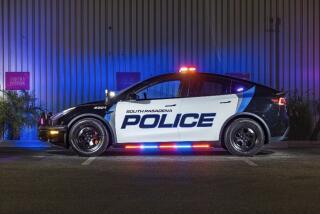Seeking a Pollution Solution : ‘Smog Dogs’ Help Testers Sniff Out High Emissions
- Share via
SANTA ANA — At first, Joe Mendoza, 30, thought a movie was being filmed. What else would explain the cameras and the two white vans on Fairview Road across from Centennial Park?
*
But when the Santa Ana motorcycle officers motioned him to the side of the road, he wasn’t sure what was going on.
Now, the Santa Ana resident is $100 richer--all because his 1988 Suzuki Samurai failed an emissions test. His vehicle will be fixed as well--courtesy of the South Coast Air Quality Management District, which is conducting a study to determine just how valuable “Smog Dogs” are.
Better known to atmosphere scientists as remote sensory devices, the so-called Smog Dogs beam infrared light across lanes of traffic, instantly recording the levels of carbon monoxide and hydrocarbons from the tailpipes of passing vehicles.
Hundreds of motorists have been pulled over in Santa Ana and Costa Mesa as part of the study, which concludes today. In the end, 140 drivers will have departed $100 wealthier, their vehicles returned to them in a more environmentally suitable condition.
“They’re the lucky ones,” said Sam Atwood, a spokesman for the district, adding that the money was an incentive for drivers to participate.
The purpose of the study is to learn whether the Smog Dogs can serve as an alternative to the Ride Sharing programs that businesses with more than 100 employees must now implement under a state law to reduce pollution.
Once the cars are fixed, emissions specialists will check to see if the levels are lower than before they were sent to the shops, and whether the Smog Dogs were accurate.
Someday, businesses might set up Smog Dogs in their parking lots, identifying employees whose cars fail emissions requirements and coming up with programs to fix them, Atwood said.
Robert Keislar, a scientist helping with the study, says that the Smog Dogs, which cost as much as $200,000 each, could be the wave of the future, supplementing or possibly replacing the biannual smog checks now required of motorists in the state.
“This could be a future scenario, a future law,” he said, referring to the technology. “It would certainly help in getting the gross emitters off the streets.”
Robert D. Stephens, a staff scientist for General Motor’s North American Operations, the inventor of Smog Dog technology, said the legislative ball is already rolling.
“As we speak, the state [Bureau of Automotive Repair] is planning to implement this on a small scale statewide,” he said.
Whether the Smog Dogs, with their hefty price tags, become as common as radar guns remains to be seen, emissions specialists said, as does the location of future inspection sites.
But for now, the Air Quality Management District just wants to come up with options for the 31,000 businesses it regulates in Los Angeles and Orange counties and portions of San Bernardino and Riverside counties.
“Sure, other parties will take a look at this to enhance the state’s smog checking program,” Atwood said. “But our primary purpose is to try to help businesses find the most economical way to reduce air pollution. They don’t have the expertise, and if they’re going to spend a good chunk of money to replace their Ride Sharing programs, they’re going to want to know whether this is going to be worthwhile.”
To determine the reliability of the Smog Dogs, the district contracted Desert Research Institute out of Reno, Nev., for $225,000. The money comes from the district’s Office of Technology Advancement, whose budget is funded in part by the $1 included in cars’ annual registration fees for air quality improvement programs.
The survey got underway May 8 on Fair Drive in Costa Mesa, where cars that failed to meet emissions requirements were stopped, the drivers informed they were only part of a study and need not participate if they didn’t want to.
Some told emissions specialists they were in a hurry or would rather not be bothered. Others, however, said they could use the repair and the extra $100, particularly those who owned more than one car.
“I’ll take it,” said Jorge Hernandez, whose 1978 Pontiac wasn’t up to par. “I can take a taxi home and use my other car.”
Then there were the few motorists who, for reasons unknown, blew past the inspection area. “We’re not trying to pressure anybody into it,” said Christopher Abe, a district worker. “It’s just that a lot of these cars have missing smog equipment or equipment that is malfunctioning or has been tampered with.”
The results of the study will be available in six months.
More to Read
Sign up for Essential California
The most important California stories and recommendations in your inbox every morning.
You may occasionally receive promotional content from the Los Angeles Times.













